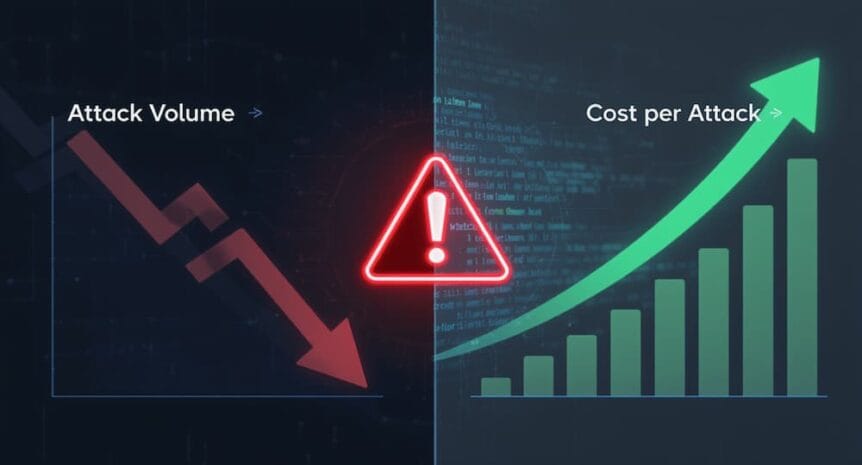The world of cybersecurity is facing a perplexing contradiction: businesses are experiencing fewer ransomware attacks than before, yet the financial damage from these incidents is skyrocketing. This unexpected development has security experts and business leaders alike questioning traditional assumptions about cyber defense and risk management.
The Current Ransomware Landscape: A Troubling Contradiction
Recent research from leading cybersecurity firms reveals a startling paradox in the ransomware landscape. While the volume of attacks has decreased significantly, the financial impact of each successful breach has intensified dramatically. Data from 2025 shows that individual ransomware incidents have become 17% more expensive during just the first six months of the year.
Perhaps most concerning, ransomware now represents approximately 75% of all cyber insurance losses, a significant jump from less than half during the same period in 2024. Insurance claims data indicates a 53% reduction in attack volume, yet the severity of each incident continues to climb.
This contradicts what many business owners might expect: that improvements in cybersecurity technology and awareness would translate to reduced financial risk. The reality is far more complex and concerning.
What the Numbers Really Tell Us
When we examine the data closely, the picture becomes clearer. The average cost of a successful ransomware attack is about $5.08 million in 2025, encompassing ransom payments, recovery expenses, downtime, legal fees, and reputational damage.
While only 22% of organizations now pay ransoms (demonstrating improved resistance to extortion attempts), those that do face increasingly severe financial consequences. The average insurance loss per ransomware incident now exceeds $1.18 million, compared to $1.01 million during the same timeframe last year.
Perhaps most alarming is the compression of attack timelines. What once took attackers days or weeks to execute now unfolds in minutes or even seconds from initial compromise to full-scale attack, dramatically reducing the window for detection and response.
Why Ransomware Attacks Are Becoming More Expensive
Cybercriminals have fundamentally changed their approach. Rather than conducting widespread, indiscriminate attacks hoping to catch anyone vulnerable, they now execute precision-targeted operations against high-value targets. This strategic shift allows them to maximize damage and financial returns while minimizing their operational footprint.
This evolution makes perfect economic sense from the attacker’s perspective. By focusing resources on carefully selected targets and investing in sophisticated attack methods, criminals can extract maximum value from each successful breach, even as their overall attack volume decreases.
AI-Enhanced Social Engineering: The New Weapon of Choice
Artificial intelligence has revolutionized the effectiveness of social engineering attacks. While industry-wide success rates vary and there isn’t a single, reliable benchmark, evidence shows AI is making phishing more convincing and efficient, enabling campaigns that tailor language, timing, and context far better than traditional methods. These sophisticated deceptions leverage machine learning to craft highly personalized, contextually appropriate communications that easily bypass traditional security awareness training.
Consider this scenario: a finance employee receives an email that perfectly mimics their CEO’s writing style, references an actual ongoing project, and requests an urgent wire transfer to a seemingly legitimate vendor. The message contains no obvious red flags, uses correct grammar and terminology, and arrives at a plausible time. This level of sophistication makes traditional “spot the phishing email” training increasingly ineffective.
Some criminal groups have even deployed AI-based systems that can analyze stolen corporate communications to create convincing impersonations of IT support staff on collaboration platforms, tricking victims into granting remote access without raising suspicion.
Double and Triple Extortion Models
Ransomware attacks have evolved far beyond simple data encryption. Modern attacks typically involve a multi-layered extortion approach:
- Data encryption that halts business operations
- Data exfiltration with threats to publish sensitive information
- Additional pressure tactics such as DDoS attacks, harassment of stakeholders, or filing false regulatory complaints
This comprehensive approach means that even organizations with robust backup systems face significant risks. Restoring from backups might address the encryption problem but does nothing to prevent the public disclosure of sensitive data or mitigate other extortion tactics.
Insurance Policy Targeting and Calibrated Demands
Perhaps most troubling is the emerging trend of cybercriminals specifically targeting cyber insurance policies during their initial reconnaissance. By accessing and analyzing these documents, attackers gain precise knowledge of coverage limits and policy details, allowing them to calibrate ransom demands accordingly.
This strategic approach ensures that demands fall within coverage parameters, increasing the likelihood of payment while maximizing the financial return. Organizations often find themselves facing ransom demands that suspiciously align with their maximum coverage limits, creating difficult decisions for leadership teams.
Industry-Specific Impact and Vulnerability Patterns
The financial impact of ransomware varies dramatically across different industries, with certain sectors facing disproportionate risks due to the nature of their data, operational requirements, and regulatory environment.
Healthcare: The Highest-Stakes Target
Healthcare organizations face the highest costs from cyber incidents, with average breach expenses around $7.42 million per incident—the highest of any industry. This sector combines several factors that make it particularly vulnerable: highly sensitive patient data, critical operational systems that directly impact patient safety, and strict regulatory requirements that complicate recovery efforts.
When healthcare systems go down, the consequences extend far beyond financial considerations to potentially life-threatening situations. Attackers know this and leverage the pressure to extract maximum payments. Importantly, paying a ransom does not guarantee full data restoration; outcomes vary and significant data gaps can remain, further compounding the damage.
Manufacturing and Critical Infrastructure
Manufacturing operations present attractive targets, with manufacturing accounting for roughly 65% of industrial ransomware incidents in Q2 2025. The highly connected nature of modern production facilities means that ransomware can rapidly spread throughout operational technology networks, bringing production lines to a complete halt.
The financial impact extends well beyond the immediate company to affect entire supply chains, creating cascading disruptions that multiply costs. Additionally, manufacturers often possess valuable intellectual property that provides additional leverage for extortion attempts.
Small and Medium Businesses: Disproportionate Targeting
Contrary to what many assume, smaller businesses are not flying under the radar. Small and midsize organizations account for a large share of confirmed breaches each year, and industry reports show thousands more confirmed breaches among SMBs than large enterprises—reflecting weaker defenses and limited incident response capabilities.
This counterintuitive pattern stems from several factors: smaller companies typically have fewer security resources, less sophisticated defenses, and limited incident response capabilities. They represent the perfect combination of vulnerability and potential payout that makes them increasingly attractive targets.
The Defensive Response: What’s Working and What Isn’t
While 98% of organizations report having ransomware response playbooks in place, less than half possess all the essential elements required to execute these plans effectively when an actual attack occurs. This gap between planning and execution capability represents a critical vulnerability that attackers readily exploit.
Prevention Strategies That Actually Work
Some defensive measures have proven particularly effective in the current threat landscape:
- Multi-factor authentication can block more than 99.2% of account-compromise attempts when properly deployed across critical systems and access points
- Network segmentation and zero-trust architecture significantly limit lateral movement during attacks, containing damage to smaller portions of the infrastructure
- Regularly tested, isolated backup systems that attackers cannot access or corrupt provide genuine recovery options
- Advanced employee training that addresses AI-enhanced threats through scenario-based exercises rather than simple awareness campaigns
Organizations implementing these core defenses consistently demonstrate greater resilience against ransomware attacks, even as threat tactics evolve.
Detection and Response Capabilities
With attack timelines compressed to minutes or seconds, detection and response capabilities have become critically important. Advanced endpoint detection and response (EDR) solutions that leverage behavioral analysis rather than signature-based detection show promise in identifying novel attack techniques before significant damage occurs.
The most successful organizations have also implemented automated containment strategies that can isolate potentially compromised systems without human intervention, buying precious time for security teams to assess and respond to threats. This shift from hours-based to minutes-based response capabilities represents one of the most significant improvements in organizational security posture.
Preparing Your Business for the New Ransomware Reality
Every business, regardless of size or industry, can take practical steps to improve ransomware resilience. The key is understanding that protection requires a comprehensive approach rather than relying on any single security measure.
Essential Technical Safeguards
Start by implementing a truly comprehensive backup strategy that goes beyond simple data copies. Ensure backups are regularly tested, stored offline or in immutable storage, and include complete system recovery capabilities, not just data files.
Network architecture improvements should focus on containment capabilities that limit lateral movement through segmentation, microsegmentation, and zero-trust principles. Implement rigorous patch management and vulnerability assessment programs that prioritize known exploited vulnerabilities over theoretical risks.
Advanced monitoring tools that focus on behavioral anomalies rather than known signatures can provide early warning of potential compromise, especially when combined with 24/7 monitoring capabilities either in-house or through managed security service providers.
Human Factor Considerations
Update employee training programs to address AI-enhanced threats through scenario-based exercises that simulate sophisticated social engineering attempts. Establish and regularly drill incident response teams to ensure they can execute recovery plans under pressure.
Develop clear decision-making frameworks for ransom payment considerations that balance legal, ethical, financial, and operational factors. These frameworks should be established before an incident occurs, when clear thinking is possible, rather than during the crisis.
Create comprehensive communication plans for stakeholder management during incidents, including templates for customer notifications, regulatory disclosures, and media statements that can be quickly customized during an actual event.
Insurance and Legal Preparedness
Work closely with insurance providers to structure cyber coverage effectively, understanding both the protections and limitations of your policy. Maintain awareness of evolving legal and regulatory requirements related to ransomware incidents, including mandatory reporting obligations.
Establish documentation and evidence preservation protocols that support potential legal actions and insurance claims. Extend your security focus beyond internal systems to include vendor and third-party risk management, as supply chain compromises represent an increasing attack vector.
Looking Ahead: Future Trends and Preparation Strategies
The ransomware landscape continues to evolve rapidly. Emerging trends suggest further refinement of targeting techniques, increased use of AI for both attack execution and victim selection, and continued evolution of extortion methods beyond simple encryption.
Businesses that remain vigilant and adaptable will fare best against these evolving threats. This requires staying informed about emerging attack techniques, regularly reassessing security controls, and maintaining a security mindset that assumes compromise is possible rather than focusing exclusively on prevention.
Perhaps most importantly, organizations must recognize that cybersecurity is not a static goal to be achieved but a continuous process of improvement and adaptation. As attackers refine their methods, defenses must evolve in parallel, creating an ongoing cycle of security enhancement that addresses the ever-changing threat landscape.
By understanding the paradoxical nature of today’s ransomware threat and implementing comprehensive protection strategies, businesses can significantly reduce both the likelihood and impact of these increasingly costly attacks.





